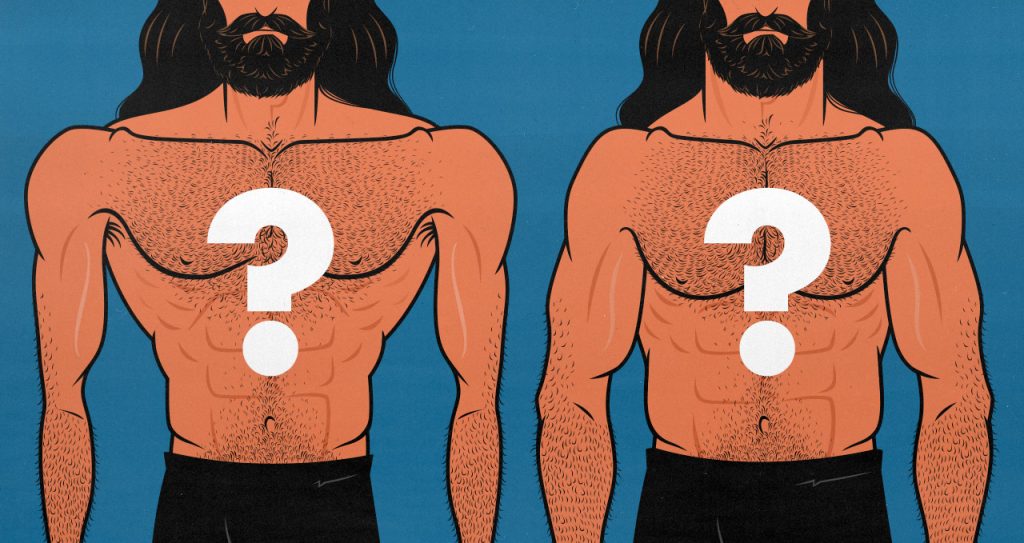
Do Skinny People Have Bad Muscle-Building Genetics?
I think it’s important to talk honestly about muscle-building genetics. I don’t mean that in a pessimistic “blackpill” way. Every skinny person can build muscle. I’m naturally skinny. So is Marco. We’ve each gained around 70 pounds. And over the past decade, we’ve worked with over ten thousand skinny clients, both male and female, ranging from desk workers to Olympic athletes.
But our genetics do indeed influence those results. Even among naturally skinny people, we all have different bone structures, different muscles that lag behind, and different muscles that pull ahead, causing us to build bodies that look rather different from one another.
So, I don’t think we should take the overly optimistic “whitepill” approach, either. If we don’t understand and account for our genetic weaknesses, we won’t ever succeed at building muscle.
Finally, for every genetic downside you have, there’s probably a genetic strength you can leverage. For the most obvious example, if you have a hard time gaining weight, you’ll have an easy time staying lean. That genetic leanness will be a powerful ally as you bulk up.
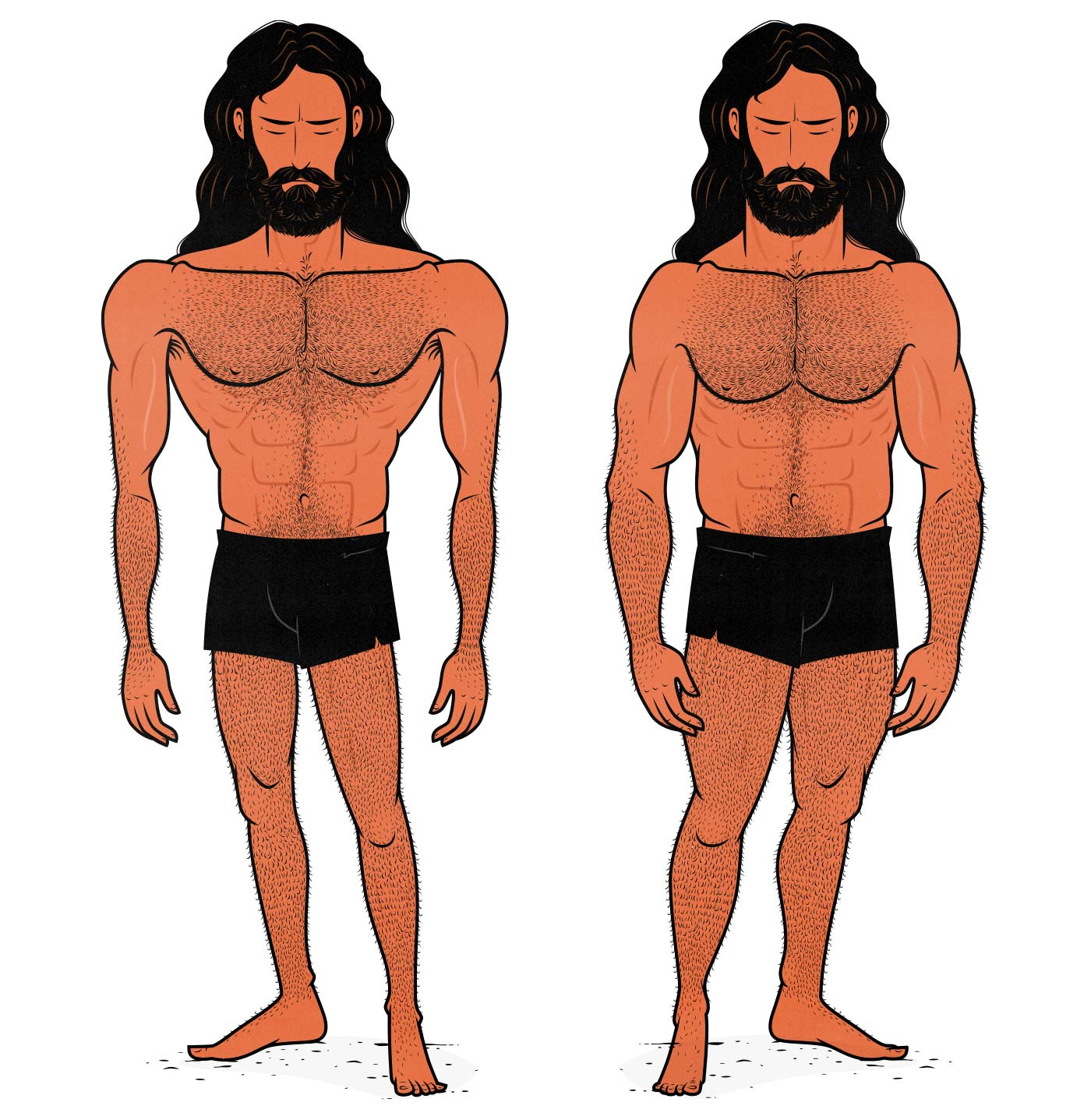
Video Version
If you’d rather watch than read, I made a YouTube video covering all the main points in the article, and you’ll get some nice visual examples along with it:
Introduction
Before we dive into this, let me lay out my bias. I was a Warhammer-loving teenager who didn’t know the first thing about exercise. Then I went off to study graphic design in university, where exercise wasn’t just unheard of, it was stupid and vain. It wasn’t until I turned twenty when I realised I had a problem. I was 6’2 and 130 pounds, which was skinny enough to worry my doctor, my family, and my friends. I wasn’t happy about it, either.
I knew my propensity for skinniness was genetic. My mother and father were naturally skinny. So was my sister. So were some of my grandparents. But I also knew I was out of shape because of my lifestyle. I figured if I started lifting weights, I could build muscle just like everyone else.
I didn’t know anything about exercise, so my first few attempts at building muscle were naive. I signed up for martial arts classes and did the callisthenics routine they gave me. That didn’t work. I tried swimming to build up broader shoulders. That was even worse. I made all the beginner mistakes. Then I learned about the concepts of bodybuilding and bulking.
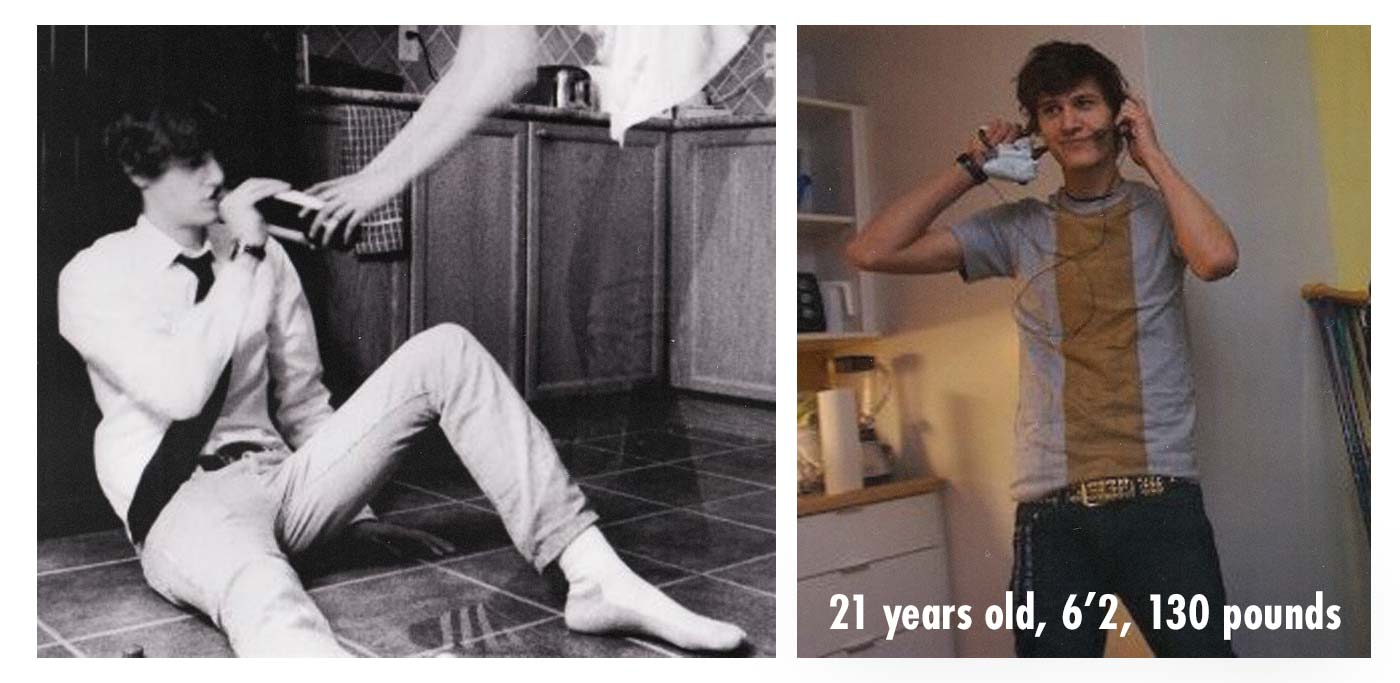
But when I first tried to bulk up, I failed at that, too. I was lifting weights, eating a healthy diet, and drinking protein shakes, but none of it worked. At all. I didn’t gain any weight. I didn’t get any stronger. I didn’t build any muscle. In fact, the combination of working out and eating healthier foods drove me into a calorie deficit. My weight dropped down to 120 pounds. I hired a personal trainer to help me out, but she couldn’t figure it out, either. She didn’t have any experience working with naturally skinny clients. I gave up.
How I Bulked Up
People kept bothering me about being skinny, so I figured maybe, just maybe, if I poured my soul into bulking up, I could build enough muscle for people to stop mentioning my skinniness all the time. I didn’t need much. My goal wasn’t to become big, muscular, or strong. I was just trying to go from clinically underweight to healthfully thin. I thought I might be able to bulk up to the point where I looked like someone who went jogging for a few weeks every January.
I eventually stumbled upon a bulking program written specifically for “ectomorphs”—for people with a genetic predisposition for skinniness. It wasn’t the best program, but it resonated with me. It taught me how to lift for muscle size and eat in a calorie surplus. It worked much better than I thought it would. I gained twenty pounds in three months, going from 130 pounds up to 150 pounds. I wasn’t clinically underweight anymore. Nobody ever commented on my skinniness ever again.
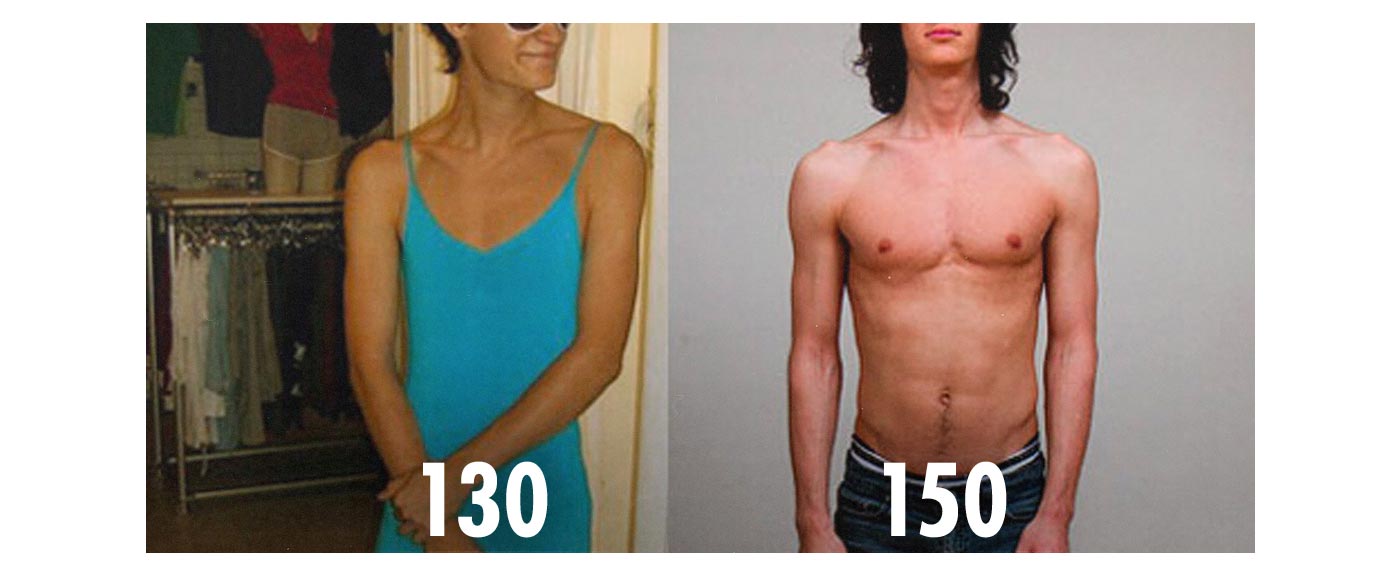
Even though I was still thin, I was totally stoked. I had accomplished my lifetime goal in just three months! That filled me with confidence, and that confidence gave me the drive to keep going. I kept lifting weights, I kept eating big, and I gained another fifteen pounds. I thought I’d reached my limit, but then I gained another twenty. And then twenty more.
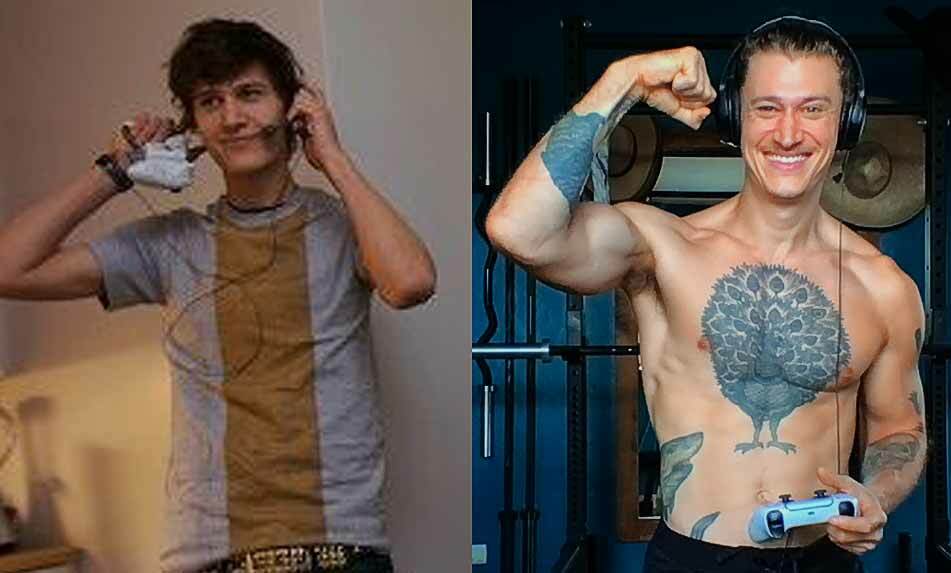
So, on the one hand, understanding my genetic predisposition allowed me to find a workout and diet program that actually suited me. On the other hand, I was totally wrong about my genetic limitations. And that mistake wound up being kind of a good thing. I’m not one of those bodybuilders tempted by steroids because I don’t feel big enough. I’m not the guy who looks in the mirror and feels bad about what I see. I’ve felt great about my body ever since getting to 150 pounds. As soon as I got “in shape,” I felt proud of my transformation.
Nobody should be blackpilled. Even the skinniest of hardgainers can build plenty of muscle. But I worry that if people get whitepilled, setting unreasonably lofty initial goals, they might never accomplish them. I worry that if people tack a photo of Arnold Schwarzenegger to their wall, they’re setting themselves up for body dysmorphia.
I also worry that if people fail to account for their genetics, as I initially did, then they won’t learn how to lift and eat in a way that suits them. In my case, I had to put a disproportionate amount of effort into eating in a sustained caloric surplus.
Normal Genetic Distribution
Genetics can create enormous differences between people. The shortest man is 1’10” and the tallest is 8’11″—nearly five times taller. Mind you, you’ve probably never seen anybody anywhere even close to either of those heights. The vast majority of people are relatively similar. That’s where normal distribution comes in:
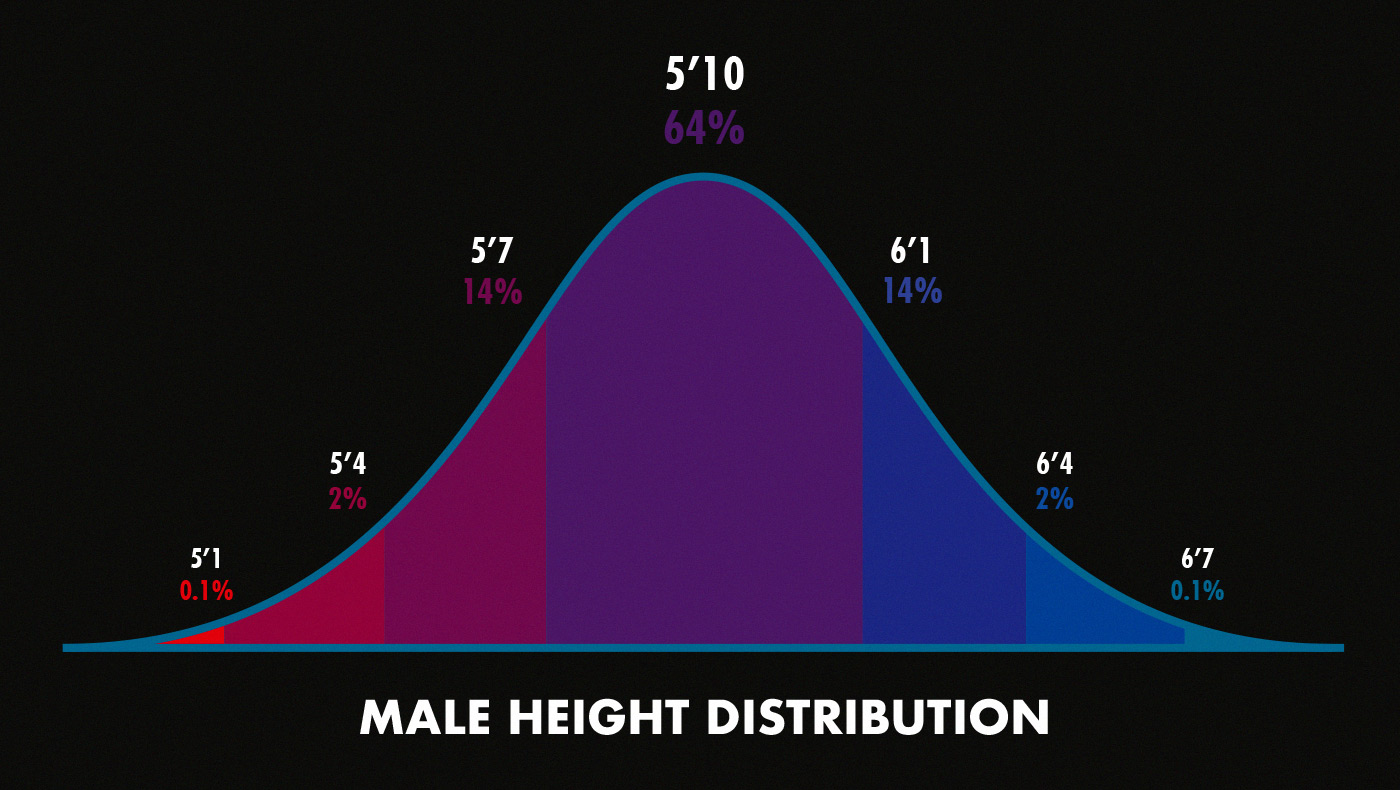
You’ve probably seen graphs like these before. It’s a bell curve. It shows how the vast majority of people have average genetics, with some people drifting off to either side, and a rare few having outlier genetics. With height, the average American man is around 5’9–5’10 with a standard deviation of around 2.5–3 inches. That means 64% of men are somewhere between 5’7 and 6’1, 95% are between 5’4 and 6’4, and 99.7% of men are between 5’1 and 6’7.
Depending on where you look, though, you might get a different impression. Even though less than 0.1% of men are 6’7 or taller, you can see a bunch of these guys standing together on a basketball team. The same is true with muscle-building genetics. Most of us are fairly similar, but if you look at a bodybuilding stage or at a group of fitness influencers, you can get a distorted idea of what’s realistic. Add performance-enhancing drugs (PEDs) into the mix and it becomes even more confusing. Does the Rock look like the Rock because of genetics, because of PEDs, or, as he claims, because of discipline?
Understanding Muscle-Building Genetics
Many genetic factors can be represented with a bell curve. Our ability to build muscle seems to be one of those factors. Some guys are enormously, freakishly muscular without ever touching a weight. Other guys need to struggle just to overcome skinniness. It gets even more confusing because where we start doesn’t determine where we end up. Most skinny guys explode in size as soon as they start bulking up, whereas many naturally bigger guys discover they’re already quite near their genetic muscular potential.
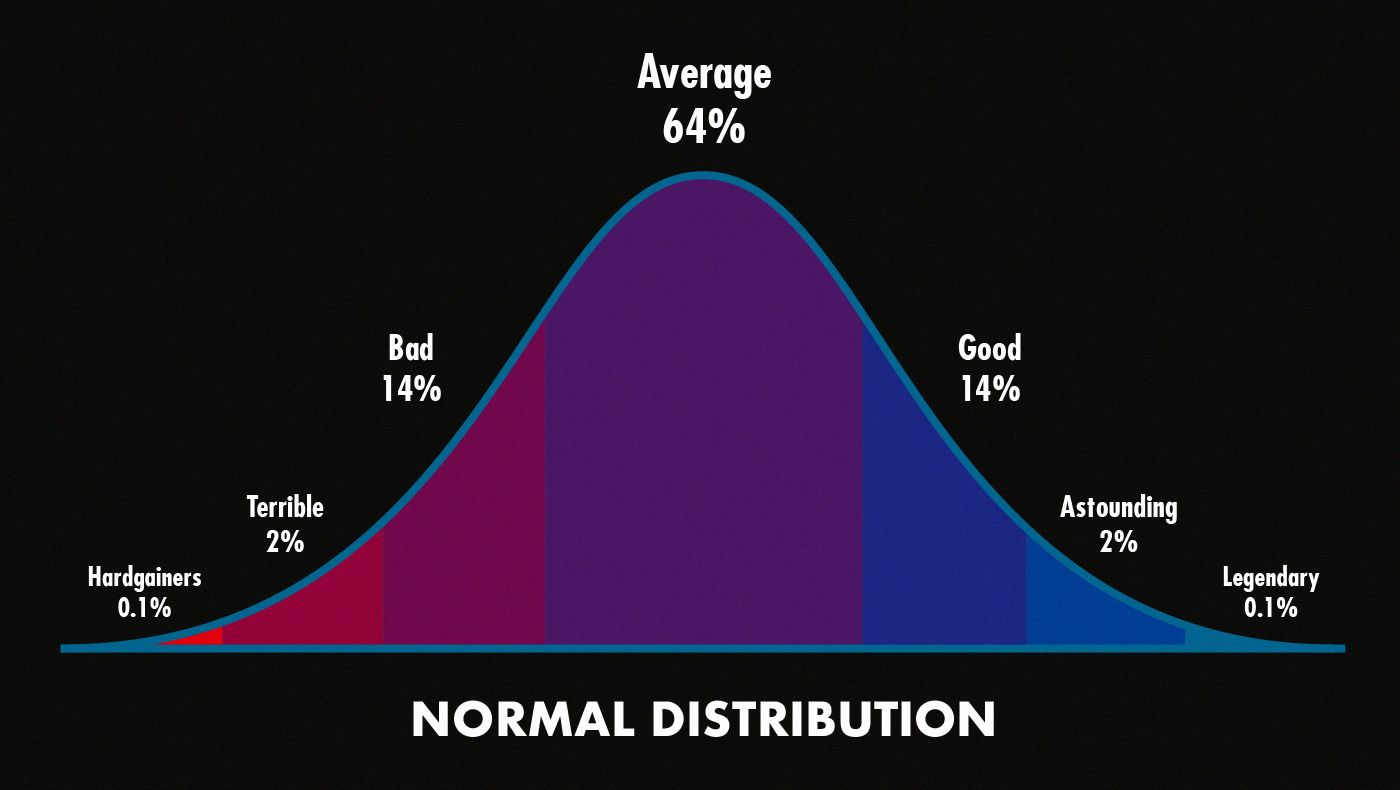
At the very far left, we’ve got the guys with “hardgainer” genetics. The scientific term used to be “non-responders,” but researchers couldn’t find anyone who didn’t respond, so the term was changed to “low-responders.” Wherever you fall on this graph, you’ll be able to build a body that looks fit, athletic, and healthy. And as you continue inching closer to your genetic potential, you can always find new ways to continue making progress. I’m twelve years into lifting weights and I’m still gaining at least a little bit of muscle and strength every year.
It’s also not uncommon for guys who have been training for several years to finally figure out a way to break past a plateau. At that point, they may discover that their genetics are far greater than they assumed.
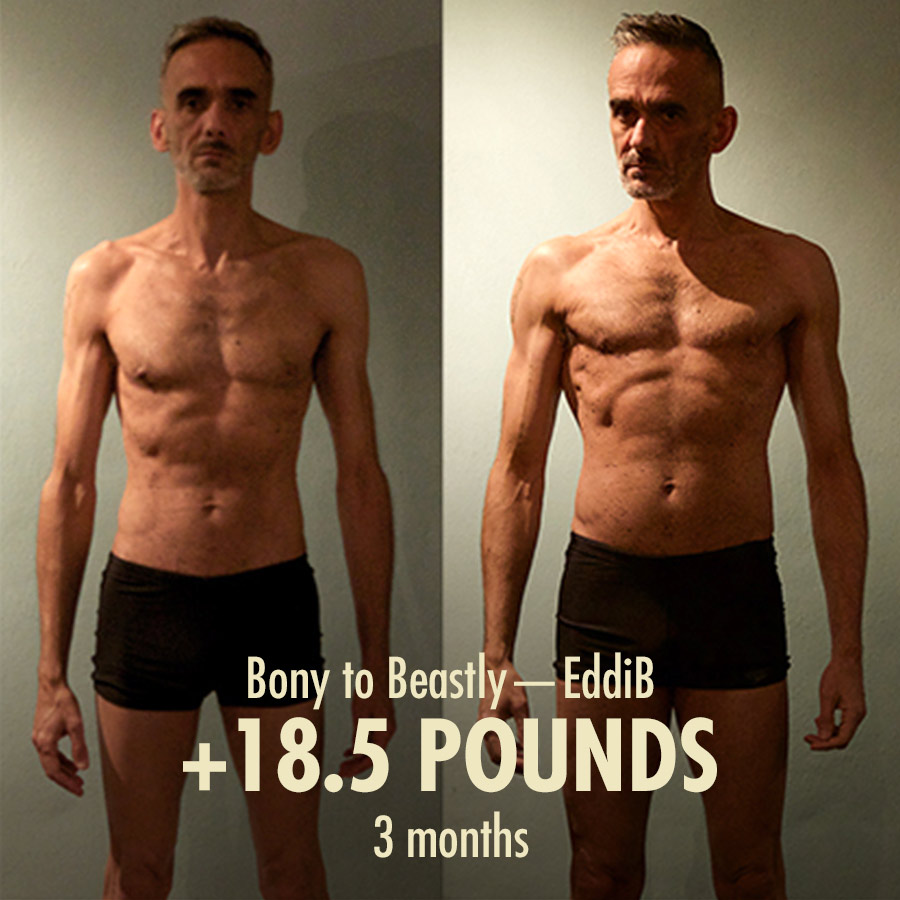
Age is a relatively minor factor, too. You can continue making progress at 18, 30, 45 or 60. It’s not until you get closer to 70 that you’ll hit your last plateau. At that point, you can focus on maintaining your strength, rolling into your eighties with as much muscle mass as you can muster. It will help you live longer, and it will also help you live better.
Just because everyone’s genetics are good enough to allow them to build muscle, though, that doesn’t mean we should ignore them. Our genetics can impact how quickly and easily we get results. Some guys can approach this more casually and build muscle more easily. Other people will need to take a slower, more deliberate approach, focusing on consistently outworking everyone else. If you gain slower, it doesn’t always mean you’re doing something wrong. And if someone else is gaining faster than you, it doesn’t necessarily mean they have a magic secret.
Skinny Guys Can Build Muscle Faster
Most of us naturally skinny guys assume that because we’re naturally skinny, we must have bad muscle-building genetics. We must be the low-responders. The hardgainers. I fell into that trap. I assumed I had the worst muscle-building genetics in the world. At first, that made me give up. That was a mistake.
There’s no known link between our starting point and our “trainability”—our ability to grow in response to hypertrophy training. That means you can’t tell how good your muscle-building genetics are before you’ve been seriously bulking up for at least a few years. You might start off half the size of your friend, but then once you get the hang of building muscle, you start gaining twice as quickly as him, eventually surpassing him four years later.
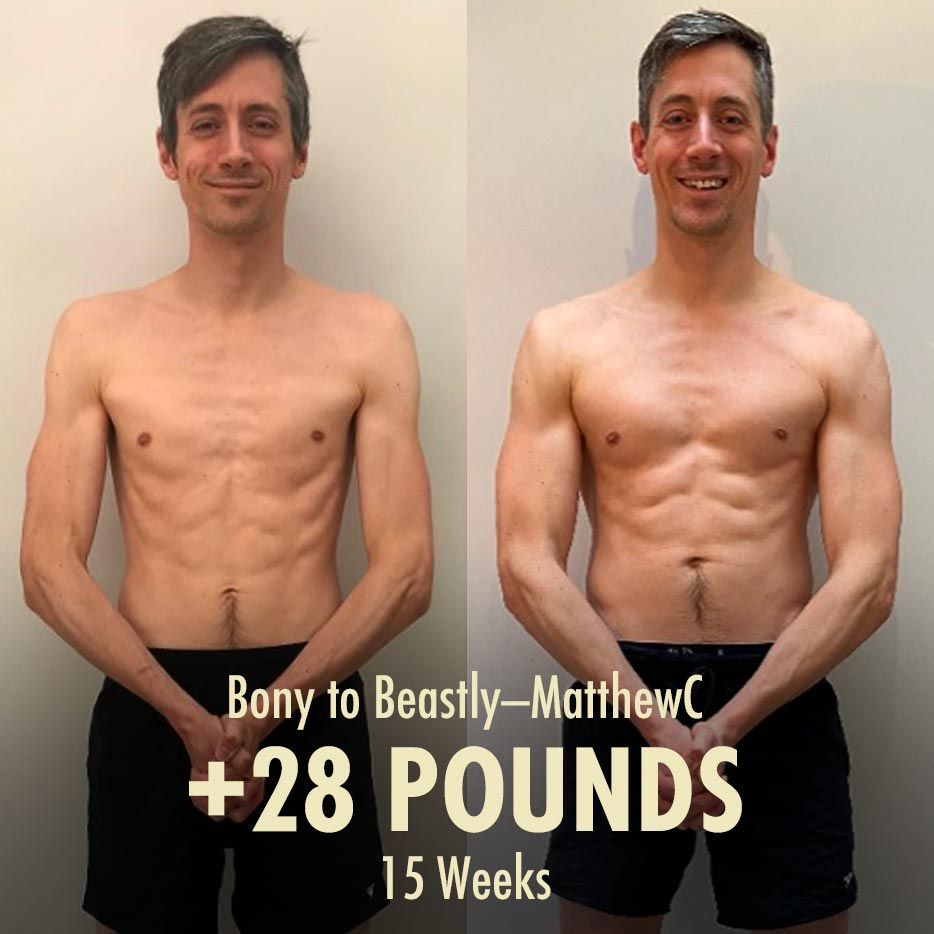
We’ve helped over ten thousand skinny guys bulk up. Some of them, like me, started off extremely underweight. Others started off closer to average. We haven’t noticed any tendency for the skinnier guys to do worse than the more average ones. If anything, the skinnier guys tend to build muscle faster, at least until they catch up to everyone else. It’s almost like there’s a sort of catch-up mechanism in place.
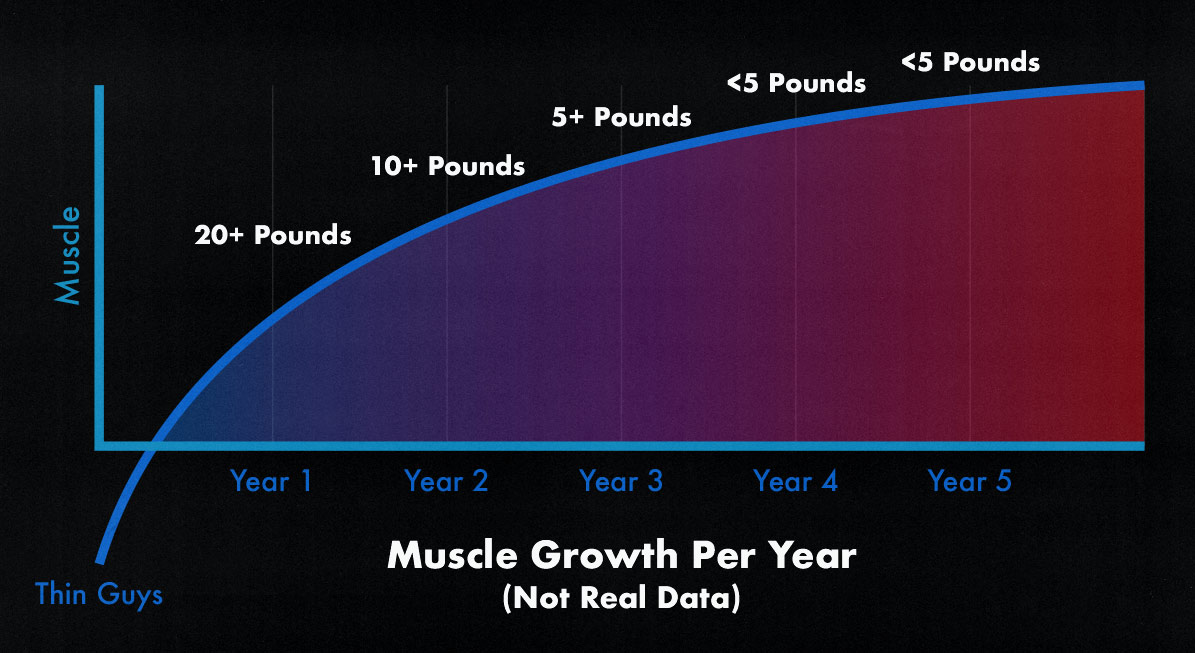
I think what’s happening is that our rate of growth is limited by how close we are to our genetic potential (full explanation). When our frames are already straining against their potential to hold muscle, it’s hard to build even more of it. With skinny guys, though, we aren’t anywhere even remotely close to our potential. Our frames can hold 30, 50, or maybe even 70 more pounds. Gaining twenty pounds is like adding a single book to an empty bookshelf.
I spoke with the leading bulking researcher, Dr. Eric Helms, about my idea that skinny guys can build muscle faster because we’re starting behind the starting line. He can’t say for sure, but he says it lines up the data, and he agrees. As for anecdotal evidence, I’m not sure anyone has more than us. I’m not sure there’s anyone in the world with more experience helping skinny guys bulk up.
The point is, with proper hypertrophy training, a sufficient bulking diet, and a healthy muscle-building lifestyle, we can grow like weeds, especially during our first few years of proper training and nutrition.
Our Great Genetic Strength
We aren’t at one, single point on the bell curve. Rather, our genetics are spread out along it. If someone’s a skinny hardgainer, they might have a small stomach, a poor appetite, and an adaptive metabolism. These genetic traits make it harder to eat enough food to bulk up. In that sense, we’re at a genetic disadvantage. But those traits also make it much easier for us to stay lean.
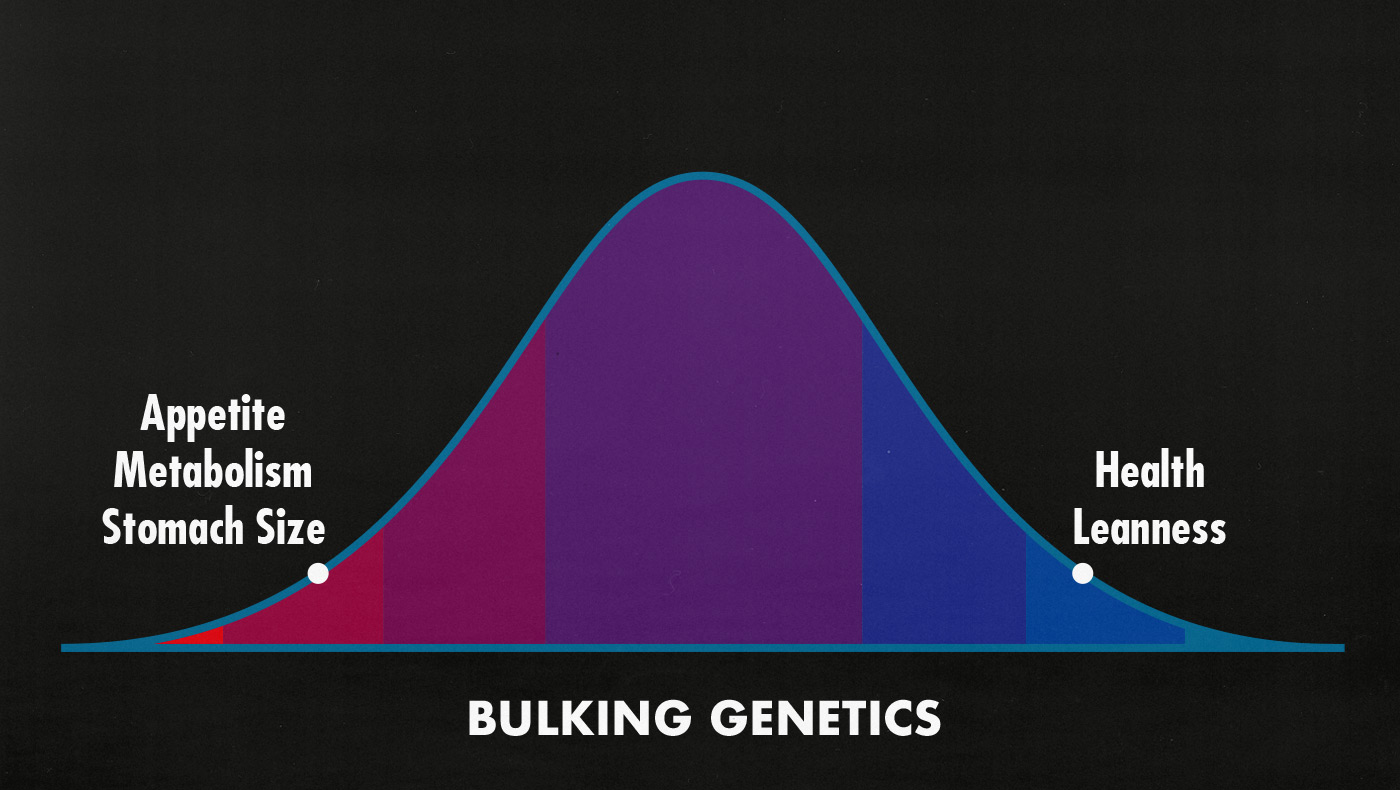
Most people tend to eat too much, putting them in a neverending siege against a ceaseless caloric onslaught. They never even get to the point where they can focus on building muscle because they’re too worried about the far more serious problem of obesity. As much as it can suck to be naturally thinner, we’d be crazy not to appreciate such a powerful genetic advantage. Not only is it much easier for us to be optimally healthy, but we don’t need to restrict our diets, stop eating before feeling satisfied, or struggle against perpetual cravings and hunger.
I know it’s hard to eat enough calories to bulk up. I used to think it was one of the hardest things in the world. I used to wish I had a different body type. But the more I learn about the struggles most people have, the more grateful I’ve become. We’ve got a great body type. Maybe even the best body type.
Stubborn vs Dominant Muscles
A ton of other muscle-building factors are spread out across this curve, too. We all have muscles that pull ahead, growing more easily. We also have muscles that lag behind, refusing to grow. That’s totally normal, and it’s hard to predict ahead of time. My chest started off small, stayed small while I gained my first twenty pounds, and then exploded in size during my second bulk (when Marco taught me how to do bench presses and push-ups properly). Building bigger arms, on the other hand, has continued to be a struggle. Mind you, even then, over time, as I continue focusing on them, my arms continue to grow. I’ve slowly gone from 10-inch arms up to 16-inch arms.
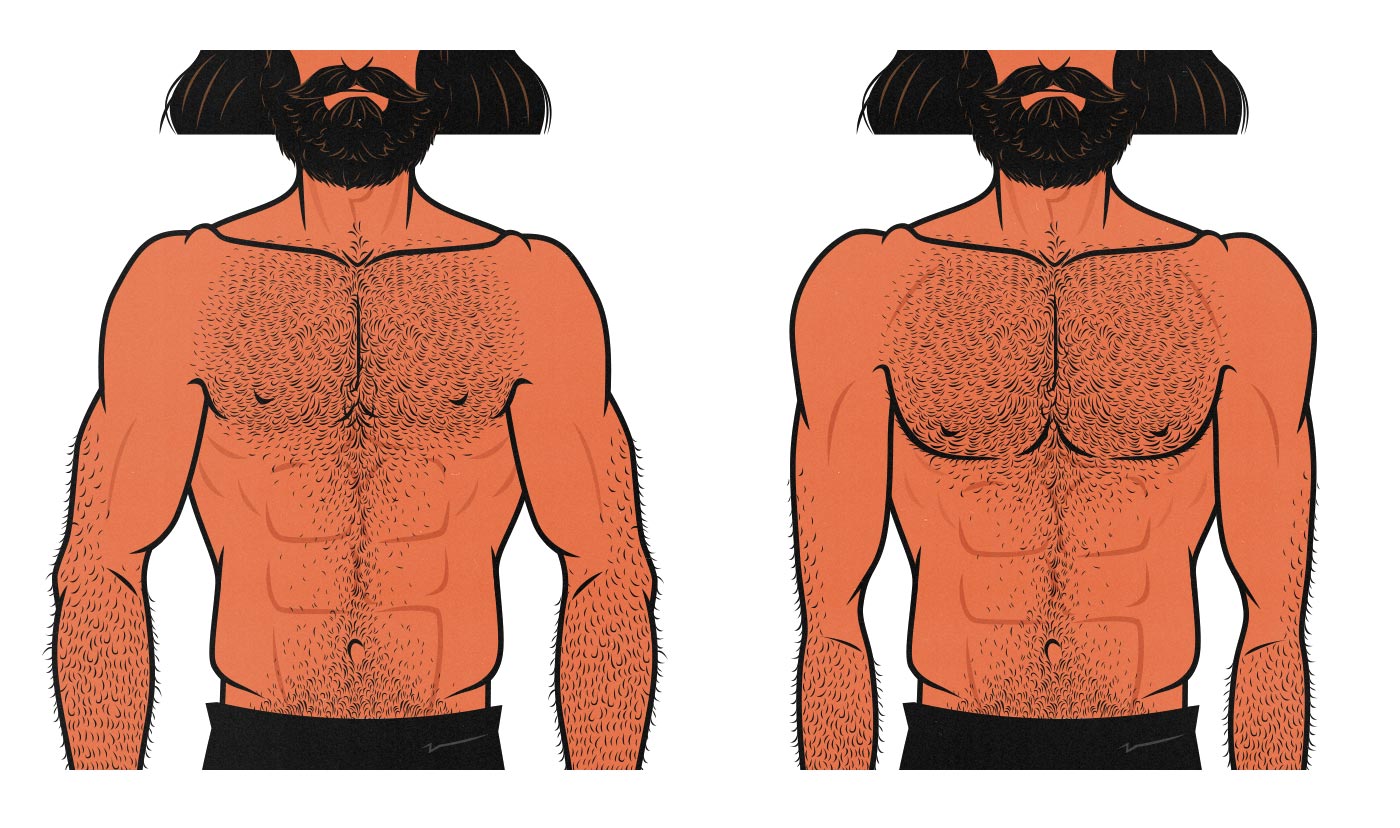
Sometimes a muscle is stubborn because we have trouble stimulating it. Maybe you’re benching with a technique that favours your shoulders instead of your chest, causing your shoulders to leap ahead while your chest lags behind.
Sometimes you’re benching with the same technique as someone else, but your bone structure is such that your shoulders have better leverage. Maybe you can fix that by adjusting your technique, or maybe you might need an entirely different exercise to stimulate that muscle properly.
Sometimes, even when you’re stimulating a muscle properly, it still lags behind. Maybe no matter how much you train your chest, it never becomes your most impressive muscle group. That doesn’t mean it won’t grow. That doesn’t mean it won’t look good. It just means that it may never look as impressive as your other muscles. And the only way to bring it back in balance would be to limit the growth of those other muscles. That might not be a worthy tradeoff. You might prefer to lean into your strengths.
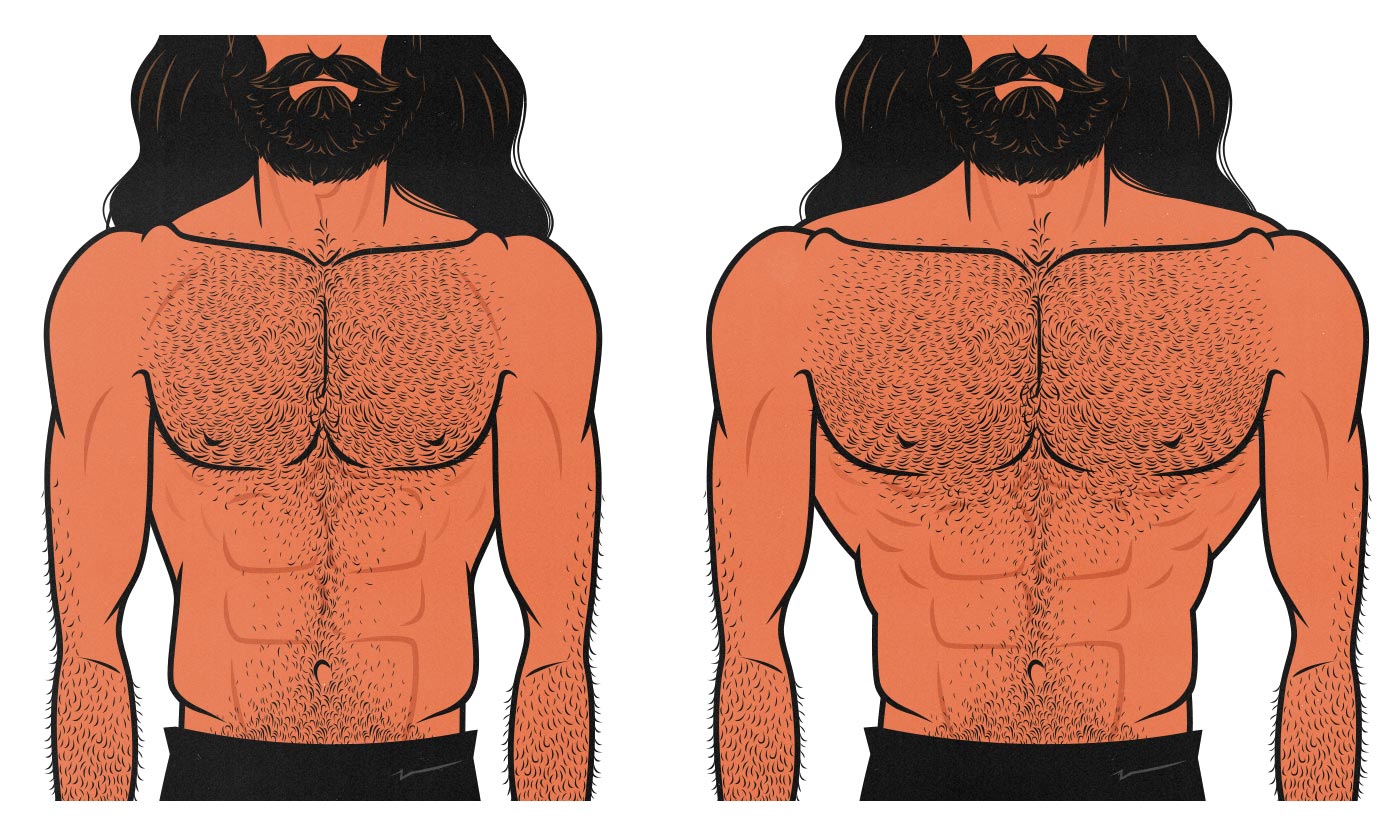
Finally, the length of your collarbones determines the width of your chest. Everyone can build a bigger chest, but not everyone can build a wider chest. This doesn’t necessarily matter. However wide your pecs are stretched, they can look great. But again, it shows that if we set overly specific bodybuilding goals, we may very well fall short of them. It also means that following in the footsteps of the guy with the big, wide chest might not give you those same results. In fact, following the advice of the guy with the smaller but more stubborn chest may actually work better for you.
Anyway, no matter how balanced we try to become, and no matter how perfect our workout programs are, we often wind up with some muscles pulling ahead of others. That isn’t necessarily a problem. Not unless you’re a bodybuilder who’s judged on muscular balance. But we’ll dive deeper into that in the next article.
Bone Structure & Muscle Growth
Let’s dive a bit deeper into how our bone structures affect our physiques. A lot of us have thinner builds with narrower shoulders and smaller waists. If we were bodybuilders, narrower shoulders would be a disadvantage, whereas a narrower waist would be a genetic strong point. And so again, a thinner build can be a mix of both good and bad genetics.
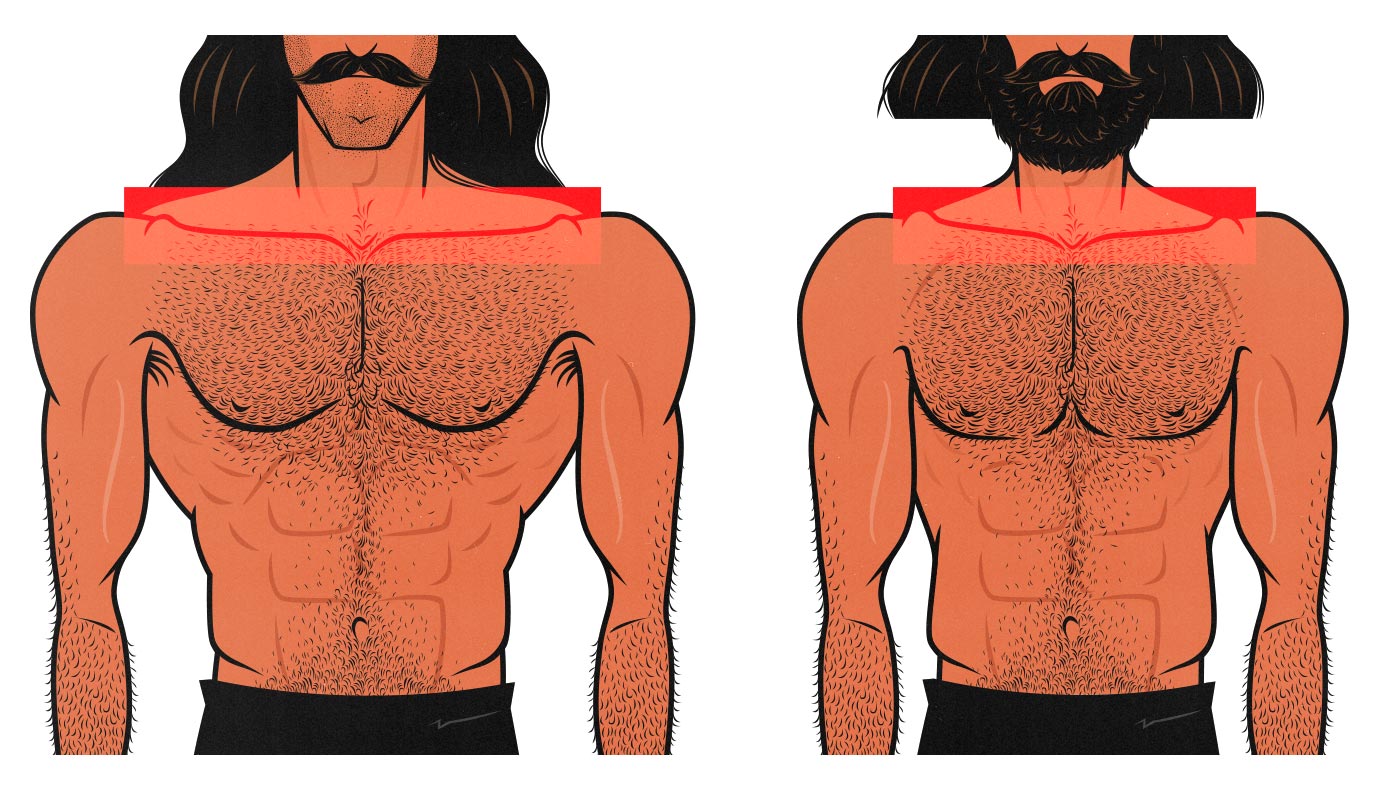
If you aren’t a bodybuilder, both wider and narrower frames can look great. Wider frames are often coveted, but when you have wide shoulders, it’s harder to make your arms, back, and neck look as muscular by comparison. When you have a narrower frame, it’s easier to look fuller. You can perfectly fill out a smaller shirt. Both looks look good.
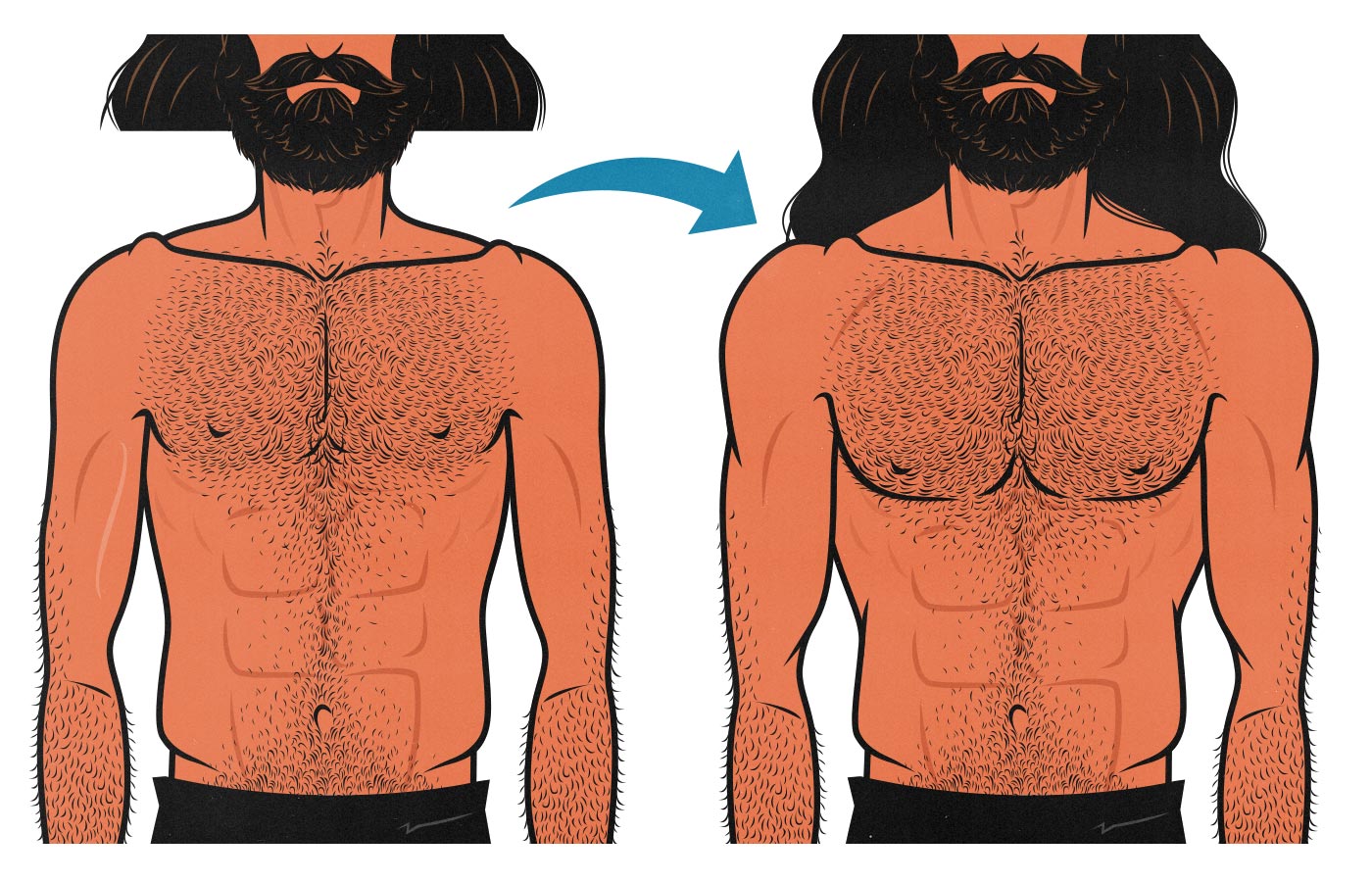
The trouble is, if you set your sights on looking like Steve Reeves, David Laid, or someone else with a dramatic V-taper physique, you may never be able to build it. You can build broader shoulders to make yourself a few inches wider, and that will look great, but you still won’t look the same as them. In a situation like that, it’s often better to focus more on building muscle and less on trying to make your body look a specific way. Again, more on this in the next article.
You may be surprised at what your bone structure looks like with more muscle on it. I assumed I had structurally narrow shoulders. I measured my shoulder circumference as a beginner and got 39 inches around, which is quite small for someone my height. After gaining seventy pounds, my shoulders are now a little over 52 inches in circumference. That was enough to go from wearing small shirts to large shirts.
The height of our bone structures has similar implications. Taller guys have longer, lankier frames that are harder to fill out. But we’re also taller, allowing us to become bigger and heavier overall. Smaller guys look proportionally more muscular—stockier. And so, however tall you are, it can be both an advantage and a disadvantage.
Bone Thickness & Muscle Growth
One of the best indicators of genetic muscular potential is the thickness of our bones. Think of it like filling up a bookshelf. The larger the bookshelf, the more dark fantasy novels it can hold.
The foremost expert in this is Dr. Casey Butt, who studied hundreds of natural bodybuilders to see which genetic factors most influenced their muscle size. Of all the factors he studied, bone thickness did the best job of predicting muscular potential. He dubbed those with thicker bones “easygainers” and those with thinner bones “hardgainers.”
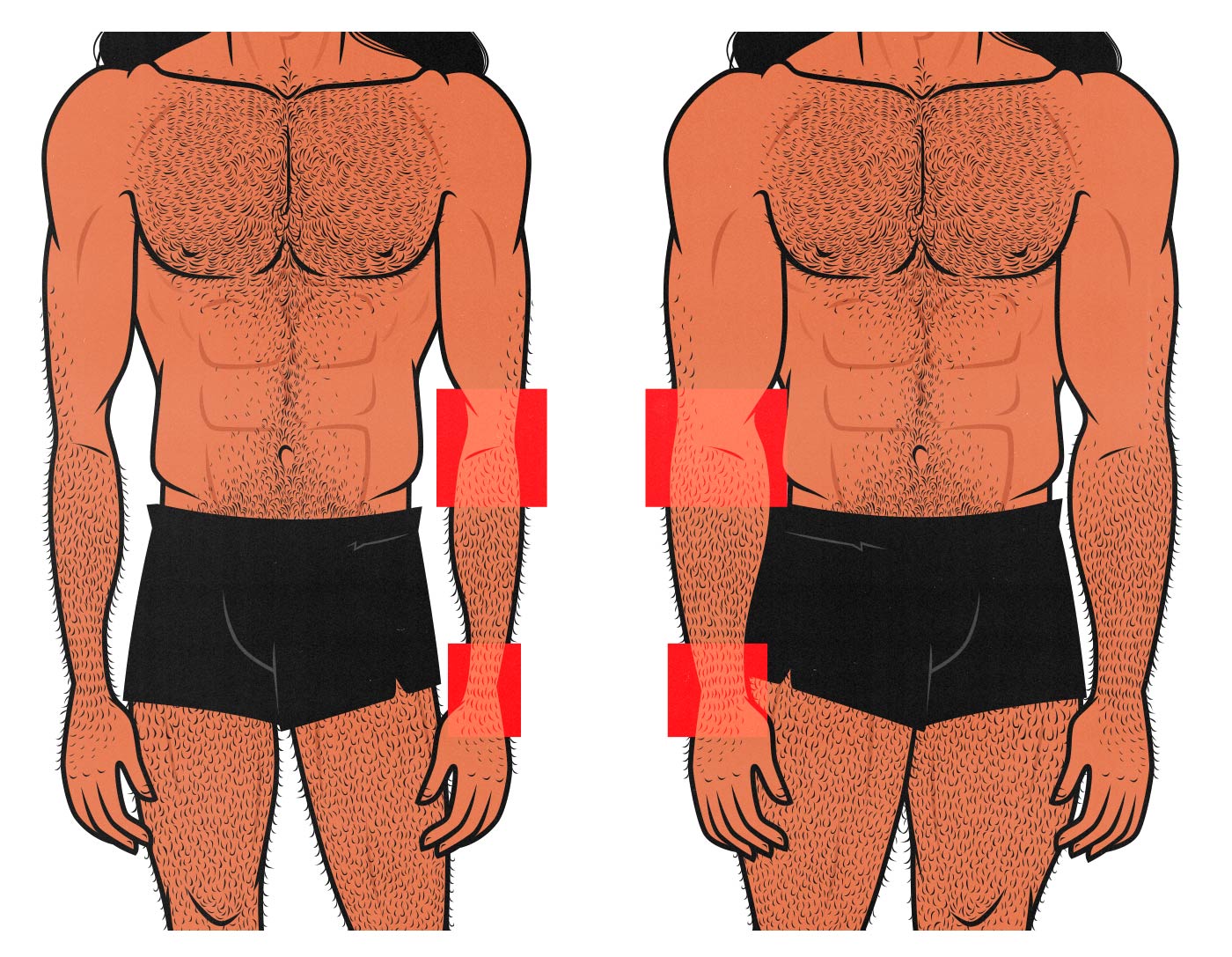
For example, people with thicker wrists and elbows tended to be able to build bigger arms, and people with thicker ankles and knee joints were able to build bigger legs. This one hit me hard because my bones are very narrow—far narrower than what he considered a “hardgainer.” As a twenty-one-year-old who was finally starting to build muscle, I was so concerned by this catastrophic news that I emailed Dr. Butt to ask if he’d ever studied someone with bones as narrow as mine. He told me no, he hadn’t.
As distraught as I was, I soon realized it didn’t really matter. Maybe I wouldn’t be able to build nineteen-inch arms, as some natural bodybuilders are able to, but I already thought my arms were looking pretty good at thirteen inches. Now I’m up to sixteen inches, and my genetics still aren’t limiting me. Plus, we don’t need to think like bodybuilders, prioritizing sheer mass over everything else. Even with aesthetics, depending on who you ask, some people prefer stockier bone structures, and others prefer thinner ones.
To my great surprise, when our readers measured themselves, the majority of them had similarly narrow bones. We cater to naturally skinny guys, so maybe that’s no great surprise, but I was still shocked to learn that my bone structure wasn’t as rare as I first assumed. And we’re all doing fine.
Finally, just to be clear, having narrow bones doesn’t mean we’ll respond poorly to hypertrophy training. It doesn’t mean we have bad muscle-building genetics. It doesn’t make us low-responders or hardgainers (unless you use Dr. Butt’s very specific definition of a hardgainer). It seems that whether you have thinner or thicker bones, you can still add books to your bookshelf just as quickly. Bone thickness only seems to impact the max size we’re able to reach in the distant future.
The Last Word
Most people have relatively average genetics, and they aren’t anywhere near as muscular as their genetics allow. Most of them are too worried about losing weight to ever make a serious attempt at building muscle. If you climb closer to your genetic potential, wherever your potential is, you can build a better physique than almost anyone you meet in real life. Moreover, we’ll be able to maintain those physiques without struggling against hunger and cravings.
Our genetics do have a fairly large impact on how we look, though. Some guys have narrower bone structures, or thinner bones, or different muscles that lag behind or shoot ahead. The trick is to take your structure as it is, and then fill it out with as much muscle as you want. Don’t set your sights on a type of physique you aren’t built for. Build the physique you have.

Alright, that’s it for now. If you want more muscle-building information, we have a free bulking newsletter for skinny guys. If you want a full foundational bulking program, including a 5-month full-body workout routine, a diet guide, online coaching, and a recipe book, check out our Bony to Beastly Bulking Program. Or, if you want a customizable intermediate bulking program, check out our Outlift Program.

